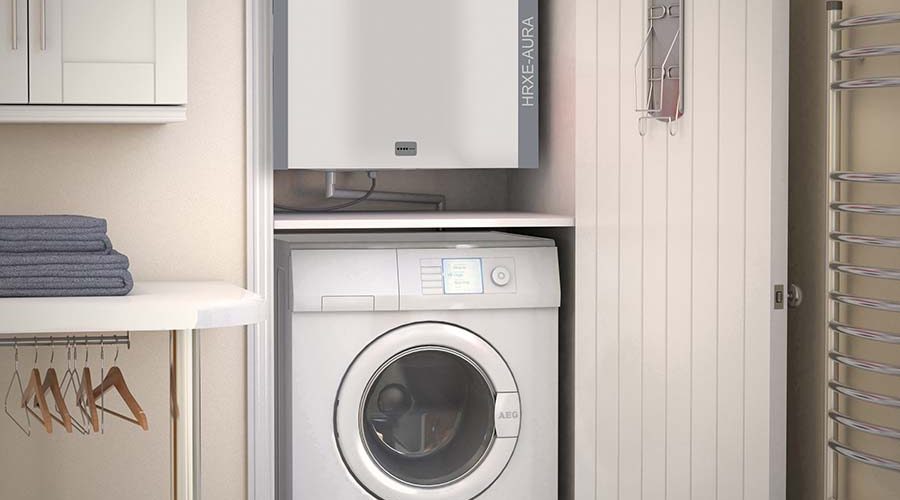With coronavirus placing more emphasis on the need for adequate ventilation in our homes, Paul Williams, Domus Ventilation’s Product Manager, discusses mechanical ventilation’s role in improving indoor air quality.
Domus Ventilation
Ventilation has become a key concern in our buildings. Ventilation has progressed from the primary concerns around condensation and mould prevention; to reducing overheating in the airtight homes we began to build in response to the Code for Sustainable Homes; through to addressing the issue of harmful indoor air pollution. Most recently, ventilation is being talked about in the light of reducing virus transmission.
Ventilation and coronavirus
Coronavirus is primarily spread in indoor environments by people breathing in infected droplets and smaller ‘aerosol’ particles in the air that have been exhaled from the nose and mouth of an infected person. Whilst masks help to limit the spread of these droplets, good ventilation is essential to disperse them.
A short film, released by the Department of Health and Social Care in November, shows how ventilation can reduce the risk of infection from coronavirus by over 70%, as fresh air dilutes the particles. The video focuses on natural ventilation through opening windows, but also acknowledges the role mechanical ventilation systems have to play when used correctly and regularly.
The benefits of mechanical ventilation in reducing transmission
Whilst extractor fans in bathrooms and kitchens provide a basic level of ventilation and are low in cost, they are only one step above opening a window. For a more effective solution, that ensures fresh air reaches all rooms in a home, and pollutants are directly extracted without losing costly heat from the property, whole-house mechanical ventilation solutions can’t be beaten, especially if you are opting for a mechanical ventilation with heat recovery (MVHR) system.
MVHR combines supply and extract ventilation in one system. The systems work on the principle of extracting and re-using waste heat from ‘wet rooms’ (kitchens, bathrooms, utility spaces). They efficiently pre-warm the fresh air drawn into the building with waste stale air using a heat exchanger. The filtered, pre-warmed air is then distributed around the home, effectively meeting part of the heating load in energy-efficient dwellings.
Domus Ventilation’s new HRXE-HERA and HRXE-AURA MVHR units feature advanced heat exchange proficiency enabling up to 95% of waste heat to be recovered. They come with 100% thermal (summer) bypass which automatically activates when the air temperature reaches a pre-set level, allowing in cooler, fresh, filtered air without warming it through the heat exchanger.
MVHR systems provide effective ventilation, are energy efficient and extremely effective at reducing the risk of virus transmission, condensation and cold air draughts.
A lower-cost, easier-to-install alternative to MVHR, mechanical extract ventilation (MEV) systems are also available. These actively extract air from ‘wet rooms’ via ducting to a central ventilation unit which exhausts to the atmosphere. The systems are typically two speeds, providing low-speed continuous trickle ventilation and high-speed boost flow. Replacement fresh air is drawn into the property via background ventilators located in the habitable rooms and through air leakage.
Both types of system have been recognised by the World Health Organization (WHO) as providing a line of defence against the spread of coronavirus.
Because of the nature of these systems, which require extensive ducting, they are mostly suited to new-build properties.
Lest we forget: Air pollution
Ventilation in our homes has never been more important, but it would be a mistake to focus solely on coronavirus as the only threat to our health. We have been in the midst of a health crisis for some time, caused by pollution in the air we breathe. According to NHS England, 30% of preventable deaths in England are due to non-communicable diseases specifically attributed to air pollution. This has been sadly brought to the fore by the recent recognition of air pollution as a cause of a person’s death for the very first time in the UK, and possibly the world.
Air pollution, notably PM2.5 and NOx, are the key concerns here, with the key emissions’ source being domestic fossil fuel burning and transport respectively. PM2.5 and NOx particles easily enter our homes around closed doors, which is where our exposure to air pollution mostly happens as we typically spend 90% of our time indoors; with coronavirus lockdown periods, this figure has increased, along with the risk to our health.
Indoor air pollution sources are also problematic and widespread, and vary dramatically from house to house. Sources include cooking, cleaning, fires, candles and even building and decorating materials.
For reducing indoor air pollutants, experts agree that both source removal and ventilation are key.
We have already looked at how whole-house mechanical ventilation systems work and how effective they are in distributing fresh air throughout the home. But in more polluted areas, such as cities, bringing air into the home also brings in dangerous pollutants, especially if the property is located near a busy road. In these instances, ventilation has to be combined with filtration. The Domus Ventilation NOX-FILT, for example, works on the supply leg of the ducting system of a mechanical ventilation system and prevents up to 99.5% of NO² pollution from entering a home. There are two units in the range with the second one having the added benefit of a PM2.5 pre-filter.
The years ahead
No one is pretending that 2021 is going to be a good year, but there is light on the horizon for sure. We are witnessing one of the biggest vaccination programmes in the history of the world in a bid to fight coronavirus. We are also seeing Governments across the world taking air pollution seriously and putting measures in place to reduce it. And we are seeing ventilation being recognised as a valuable and relatively low-cost means of improving our indoor environment and our health.









